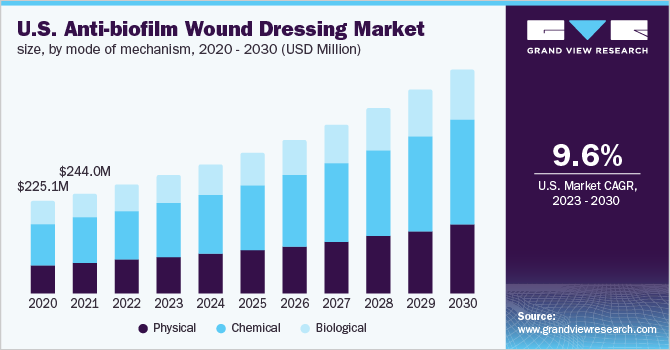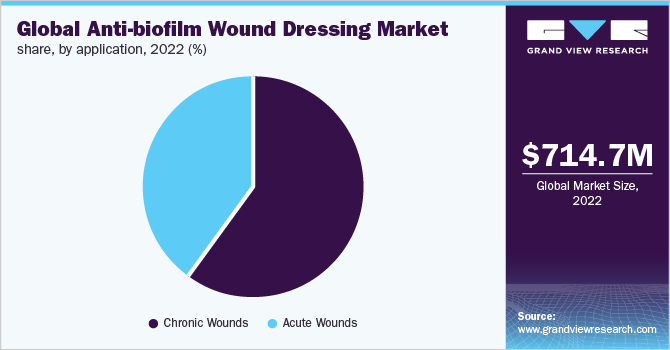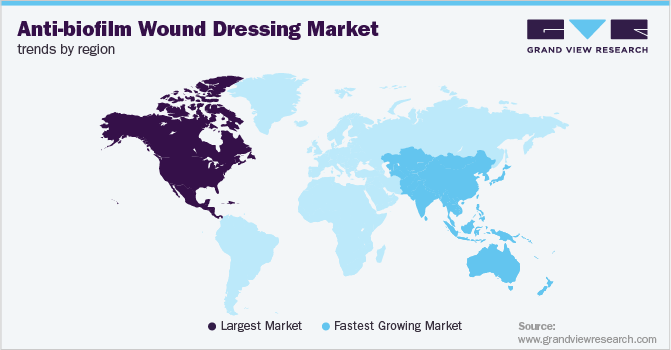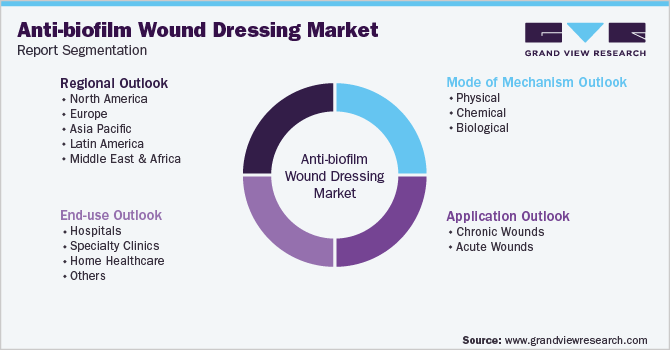- Home
- »
- Medical Devices
- »
-
Anti-biofilm Wound Dressing Market Size & Share Report, 2030GVR Report cover
![Anti-biofilm Wound Dressing Market Size, Share & Trends Report]()
Anti-biofilm Wound Dressing Market Size, Share & Trends Analysis Report By Mode Of Mechanism (Physical, Chemical, Biological), By Application (Chronic Wounds, Acute Wounds), By End-use, By Region, And Segment Forecasts, 2023 - 2030
- Report ID: GVR-4-68038-948-7
- Number of Report Pages: 97
- Format: PDF, Horizon Databook
- Historical Range: 2018 - 2021
- Forecast Period: 2023 - 2030
- Industry: Healthcare
Report Overview
The global anti-biofilm wound dressing market was valued at USD 714.7 million in 2022 and is expected to expand at a compound annual growth rate (CAGR) of 9.6% from 2023 to 2030. The increasing incidence of chronic diseases such as diabetes, cancer, and other autoimmune diseases is anticipated to increase the incidence rate of chronic and acute wounds across the globe. Factors such as antimicrobial resistance, unhealthy & sedentary lifestyles, and tobacco & alcohol consumption are contributing to the rising prevalence of non-communicable diseases. For instance, according to the CDC’s National Diabetes Statistics report of 2020, the number of diabetes patients has increased to an estimated 34.2 million, which comprises about 10.5% of the total population. According to a similar report, an estimated 26.8 million people have been diagnosed with diabetes, whereas 7.3 million people had diabetes and were yet to be diagnosed.

Chronic wounds and surgical wounds all have a deleterious impact on wound recovery. The growing geriatric population, rising prevalence of traumatic wounds, an increasing number of surgeries, and rising incidence of illnesses, such as obesity & diabetes, are among the factors contributing to the rising prevalence of chronic wounds over the last decade. As per the studies conducted by B. Braun Melsungen AG in 2018, around 2.0% to 10.0% of diabetic people suffer from diabetic foot ulcers.
In addition, as per the American College of Physicians, in 2017, the global annual incidence rate of diabetic foot ulcers is around 6.3% and the lifetime incidence rate of foot ulcers in patients suffering from diabetes ranges from 19.0%-34.0%. Since anti-biofilm wound dressing products are highly recommended for treating chronic wounds thus, this factor is expected to immensely boost the market growth.
According to the U.S. CDC, 6 in 10 adults are suffering from a chronic disease and 4 in 10 adults are suffering from two or more chronic diseases in the U.S. Furthermore, chronic diseases are the leading cause of disability & death and a key contributor to the country’s USD 3.5 trillion annual healthcare costs. As a result of the rising prevalence of chronic conditions, the number of surgeries being performed has increased. Wound dressing products such as silver-based wound dressing are increasingly being used to prevent surgical site infections.
Most surgical wounds after cancer surgery are generally large in size & deep, producing exudate that requires regular management. Anti-biofilm wound dressing products such as silver, and iodine-based wound dressings help to manage large wounds, thus, reducing the risk of infection. Therefore, the rising incidence of chronic diseases is expected to boost the demand for the products, thereby propelling the growth of the market over the forecast period.
Increasing incidence of burns, trauma events, and road accidents across the globe is anticipated to drive market growth. For instance, as per Association for Safe International Road Travel, approximately, 1.35 million people die every year in a road crash, whereas on average 3,700 people lose their lives every day on the road. Thus, the rising number of accidents is expected to boost the demand for enzymatic wound debridement products, which is expected to lead to considerable growth in the industry over the forecast period.
In addition, according to Stanford Children’s Health, injury is a major cause of child admission in hospitals & emergency departments. Thus, the rising number of accidents is expected to boost the demand for products, which is expected to lead to considerable anti-biofilm wound dressing market growth over the forecast period.
Furthermore, as more people are participating in sports and recreational activities, the risk of injuries is increasing. For instance, according to Stanford Children’s Health, over 3.5 million injuries are reported annually among children & teens in the U.S., and around 21% of all injuries are traumatic brain injuries. Moreover, according to a similar source, 254,000 children are injured annually due to bicycle-related accidents in the U.S.
Similarly, according to American Physical Therapy Association (APTA) 2017 report, approximately 8.6 million sports injuries are reported in the U.S. each year. Thus, an increase in the incidence of injuries is anticipated to drive the demand for anti-biofilm wound dressing products, thereby aiding in industry growth.
The Russia-Ukraine war has severely impacted the health system due to damage to health infrastructures, such as hospitals and clinics. Due to storage space issues and the expense of maintaining a big inventory, the majority of hospitals rarely have supplies of medications and consumables that last longer than a few days. Particularly commodities required for treating war injuries, such as antibiotics, blood supplies, and wound dressings, are exhausted from these stocks.
It will be extremely challenging to provide healthcare in Ukraine, and it will be challenging to determine the entire degree of the interruption to the health system, especially since cyberattacks have affected IT systems. This is made worse by the ongoing COVID epidemic, which has about 1,700 patients now being treated in hospitals across the nation, as stated by a press release published in OCHA, ReliefWeb, March 2022.
Primary care, screening, and immunization programs have been disrupted. This implies that those with chronic illnesses like diabetes or heart failure might not receive the best care possible. The post-war era is frequently marked by instability, political unpredictability, infrastructure damage and degradation, inadequate healthcare resources and staffing, unemployment, and a wide range of product shortages. The economy will continue to be impacted, and social and familial networks will be disrupted. Ukraine will require significant international assistance and finance to reconstruct and recover after the war, which will extend for many years.
Various organizations and market players are meeting the health needs of children and adults in Ukraine and surrounding countries affected by Russia’s invasion of Ukraine. For instance, since February 2022, Americares has supplied over 242 tons of pharmaceuticals and medical supplies worth over USD 48 Million to Ukrainian hospitals and emergency responders, and additional shipments are on the way. These shipments contain trauma kits, IV fluids, wound care supplies, antibiotics, and labor and delivery equipment.
Mode Of Mechanism Insights
The chemical mode of mechanism segment held the largest market share of around 44.7% in 2022 and is anticipated to witness significant growth over the forecast period owing to the rising prevalence of chronic wounds and an increasing number of surgeries across the globe. The chemical-based anti-biofilm wound dressing products allow multi-faceted action against biofilm thereby increasing the healing rate and recovery efficiency of chronic wounds. It also reduces the biofilm burden on both chronic & acute wounds and lowers the risk of acquiring recontamination with microorganisms. The chemical segment is further fragmented into ionic silver, iodine, EDTA, and others.
The chemical mode of mechanism segment is anticipated to witness the fastest CAGR over the forecast period. The presence of several players offering anti-biofilm wound dressing products with iodine and ionic silver is the major factor promoting segment growth. In addition, researchers are also taking the initiative to introduce advanced anti-biofilm wound dressing products in the market for better treatment of chronic and acute wounds. For instance, in June 2020, the National Biofilms Innovation Centre of the U.K. announced a grant of USD 28,949.03 to research and introduce new product lines related to managing, engineering, and detecting biofilms. Therefore, all these factors are anticipated to positively impact the market growth over the forecast period.
Application Insights
The chronic wounds segment held the largest revenue share of around 59.9% in 2022 owing to the increasing cases of chronic diseases, especially diabetes, across the globe. Chronic or non-healing wounds occur when there is no significant healing of an injury for about 4 weeks. These types of wounds progress and will heal slower than expected or will not heal at all. The symptoms of chronic wounds include increased infection and pain in the wound. This can be due to pressure on or around the wound, exposure to bacteria or trauma, or insufficient blood & oxygen supply. It is estimated that 1%-2% of the population will suffer from a chronic wound once in their lifetime.
In the U.S., it is stated that chronic wounds affect around 6.5 million people. Moreover, the incidence of chronic wounds is expected to increase with aging and will impose a significant financial burden on society. It is estimated that more than USD 25 billion is spent by the healthcare system on treating wound-related complications every year in the U.S. In addition, as per the American Diabetes Association (ADA), more than 9-12 million people in America suffer from chronic ulcers. Thus, increasing cases of chronic diseases, especially diabetes, and the rising geriatric population across the globe are the major drivers of the segment. These common wounds have different characteristics. There are many common types of chronic wounds. The chronic wound segment is further fragmented into diabetic foot ulcers, pressure ulcers, venous leg ulcers, and others.

The acute wounds segment is anticipated to witness the fastest growth over the forecast period owing to the rising cases of burns & trauma and the increasing number of surgeries across the globe. An acute wound is an injury to the skin that occurs unexpectedly and includes incisions, abrasions, burns, scratches, and puncture wounds. It heals at a normal rate according to the regular wound healing process.
These types of wounds can take place anywhere on the body and differ from small scratches to deep wounds. The acute wounds segment is further classified into surgical or traumatic wounds and burn wounds. Treating acute wounds will depend on the severity and location of the wound. However, the primary treatment includes wound dressing and prevention against biofilm formation. Thus, the increasing number of patients suffering from acute wounds is expected to boost the market growth.
End-use Insights
The hospital segment dominated the market for wound care and held the largest revenue share of 45.3% in 2022. The growth of this segment can be attributed to the upsurge in surgical procedures and the increasing sports-related injuries, burn and trauma cases, that require the use of wound care products to contain surgical site infections. For instance, the Canadian Institute of Health (CIH) reported that over 271,037 persons were hospitalized between 2019 and 2020 owing to sports-related injuries. In addition, hospital institutions are considered large buyers of wound care having long-term contracts with suppliers. Hence, owing to the aforementioned factors, the segment is anticipated to propel during the forecast period.
The home healthcare segment is expected to witness the fastest CAGR of 10.3% during the forecast period. During the pandemic outbreak, home healthcare wound care products were more in demand. These services offer several advantages to patients such as personal care and home-delivered meals, among others. This is expected to act as a major driver for the market. According to the U.S. Bureau of Labor Statistics, in the U.S., the number of home healthcare and personal care aides is expected to reach 13.0 Million in 2020. Moreover, the increasing geriatric population across the globe is likely to promote home healthcare services as aged people are more likely to avail of such services.
Moreover, an increasing number of geriatric populations is expected to propel the segment. The geriatric population tends to opt for homecare settings or nursing home care. For instance, as per Inter-American Development Bank, in 2020,15.7% of the Argentinian population was above the age of 60. Moreover, this number is projected to increase up to 22% by 2050. Furthermore, the presence of several organizations offering home care services in North America and Europe is promoting the home care services market. Thus, owing to the aforementioned factors, the segment is anticipated to impel during the forecast period.
Regional Insights
North America dominated the anti-biofilm wound dressing industry in 2022 and is expected to witness a considerable CAGR of 9.7% over the forecast period. The increasing incidence of sports injuries, the rising number of road accidents, and the presence of several key players in the region are some of the factors expected to drive the market growth. In addition, the presence of a highly developed healthcare infrastructure and favorable reimbursement policies are expected to propel the market growth over the forecast period.
Asia Pacific anti-biofilm wound dressing market is anticipated to witness the fastest growth during the forecast period. The presence of developing countries such as China, India, and Japan is anticipated to boost market growth in the Asia Pacific region. In addition, the rapidly aging population in this region, along with an increasing number of obese and diabetic patients, the use of anti-biofilm wound dressing products in this region is anticipated to increase. Moreover, medical tourism in this region has also attributed to increasing demand for anti-biofilm wound dressing products. The rising geriatric population is one of the major driving factors for the market growth in Japan. According to Europa, more than one in four people are above 65 years of age. As the geriatric population is at a higher risk of various diseases and disabilities, an increase in the geriatric population may propel the demand for wound care products.

Latin America is anticipated to grow at a considerable rate during the forecast period. The presence of developing economies, such as Brazil and Mexico, is expected to primarily drive the overall Latin America market. The availability of advanced treatment options at low cost in Latin America is making the region a preferred destination for medical tourism. In addition, governments of Latin American countries are consistently involved in improving healthcare infrastructure. Thus, such factors are expected to fuel the growth of the market over the forecast period.
Key Companies & Market Share Insights
Competitive rivalry and degree of competition in the market are expected to intensify over the forecast period due to the presence of major players in the market. Companies are stressing research and development to develop technologically advanced products to gain a competitive edge. For instance, in January 2018, Imbed Biosciences raised a fund of around USD 1.6 million to introduce the silver-based anti-biofilm wound dressing product, Microlyte Ag in the market, after the completion of their research on this product.
Companies are engaging in partnerships, mergers, and acquisitions, aiming to strengthen their product portfolio, and manufacturing capacities, and provide competitive differentiation. For instance, in April 2019, Smith & Nephew PLC announced the acquisition of Osiris Therapeutics, Inc., which specializes in regenerative medicine products. With this acquisition, the company will accelerate the development of its advanced wound management product portfolio, thereby expanding its customer pool and market reach. This initiative is anticipated to boost the growth of the company. Some prominent players in the global anti-biofilm wound dressing market include:
-
ConvaTec Inc.
-
Smith & Nephew PLC
-
Urgo Medical
-
Coloplast
-
3M
-
Mölnlycke Health Care AB
-
Imbed Biosciences
-
Next Science
-
B. Braun Melsungen AG
-
Lohmann & Rauscher
Anti-biofilm Wound Dressing Market Report Scope
Report Attribute
Details
Market size value in 2023
USD 777.89 million
Revenue forecast in 2030
USD 1,478.39 million
Growth rate
CAGR of 9.6% from 2023 to 2030
Base year for estimation
2022
Historical data
2018 - 2021
Forecast period
2023 - 2030
Quantitative units
Revenue in USD million and CAGR from 2023 to 2030
Report coverage
Revenue forecast, company ranking, competitive landscape, growth factors, and trends
Segments covered
Mode of mechanism, application, end-use, region
Regional scope
North America; Europe; Asia Pacific; Latin America; Middle East and Africa
Country scope
U.S.; Canada; U.K.; Germany; France; Italy; Spain; Denmark; Sweden; Norway; Japan; China; India; Australia; South Korea; Thailand; Brazil; Mexico; Argentina; Colombia; South Africa; Saudi Arabia; UAE; Kuwait
Key companies profiled
ConvaTec Inc.; Smith & Nephew PLC; Urgo Medical; Coloplast; 3M; Mölnlycke Health Care AB; Imbed Biosciences; Next Science; B. Braun Melsungen AG; Lohmann & Rauscher
Customization scope
Free report customization (equivalent up to 8 analysts working days) with purchase. Addition or alteration to country, regional & segment scope.
Pricing and purchase options
Avail customized purchase options to meet your exact research needs. Explore purchase options
Global Anti-biofilm Wound Dressing Market Segmentation
This report forecasts revenue growth at global, regional, and country levels and provides an analysis of the latest industry trends in each of the sub-segments from 2018 to 2030. For this study, Grand View Research has segmented the global anti-biofilm wound dressing market report based on mode of mechanism, application, end-use, and region:

-
Mode of Mechanism Outlook (Revenue, USD Million, 2018 - 2030)
-
Physical
-
Manual Debridement
-
Pulse Electrical Field
-
Ultrasound Debridement
-
-
Chemical
-
Ionic Silver
-
Iodine
-
EDTA
-
Others
-
-
Biological
-
Dispersin B
-
Lactoferrin
-
Bacteriophage
-
Others
-
-
-
Application Outlook (Revenue, USD Million, 2018 - 2030)
-
Chronic Wounds
-
Diabetic Foot Ulcers
-
Pressure Ulcers
-
Venous Leg Ulcers
-
Others
-
-
Acute Wounds
-
Surgical & Traumatic Wounds
-
Burn Wounds
-
-
-
End-use Outlook (Revenue, USD Million, 2018 - 2030)
-
Hospitals
-
Specialty Clinics
-
Home Healthcare
-
Others
-
-
Regional Outlook (Revenue, USD Million, 2018 - 2030)
-
North America
-
U.S.
-
Canada
-
-
Europe
-
Germany
-
U.K.
-
France
-
Italy
-
Spain
-
Sweden
-
Denmark
-
Norway
-
-
Asia Pacific
-
Japan
-
China
-
India
-
Australia
-
South Korea
-
Thailand
-
-
Latin America
-
Brazil
-
Mexico
-
Argentina
-
-
Middle East & Africa
-
South Africa
-
Saudi Arabia
-
UAE
-
Kuwait
-
-
Frequently Asked Questions About This Report
b. The global anti-biofilm wound dressing market size was estimated at USD 714.7 million in 2022 and is expected to reach USD 777.89 million in 2023.
b. The global anti-biofilm wound dressing is expected to grow at a compound annual growth rate of 9.6% from 2023 to 2030 to reach USD 1,478.39 million by 2030.
b. North America dominated the anti-biofilm wound dressing market with the highest share of 43.4% in 2022. This is attributable to rising healthcare awareness coupled with technological advancements.
b. Some key players operating in the anti-biofilm wound dressing market include ConvaTec, Urgo Medical, Smith & Nephew, and Coloplast.
b. Key factors driving the anti-biofilm wound dressing market growth include rising demand for innovative wound care products and a rising number of surgical wounds.
Share this report with your colleague or friend.
![gvr icn]()
NEED A CUSTOM REPORT?
We can customize every report - free of charge - including purchasing stand-alone sections or country-level reports, as well as offer affordable discounts for start-ups & universities. Contact us now
![Certified Icon]()
We are GDPR and CCPA compliant! Your transaction & personal information is safe and secure. For more details, please read our privacy policy.
We are committed towards customer satisfaction, and quality service.
"The quality of research they have done for us has been excellent."





